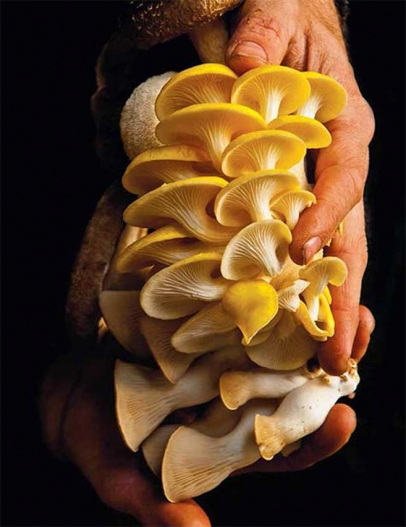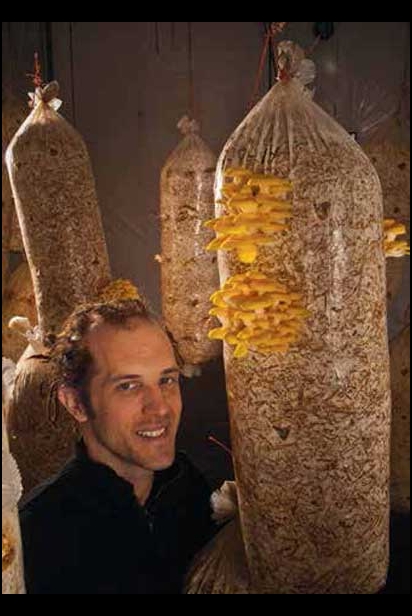Business is Mushrooming
Favorite Fungi Offer Tasty and Healthy Appeal
A conversation with Eric Osborne can take you many places in a very short time, from the annals of medicine to outer space, from Jamaican culture to Iroquois Park.
Osborne is a mycologist and mycophile: a mushroom lover, nurturer, seller, proselytizer. And the places he goes and very often the stories he tells involve mushrooms— relating studies showing the fungi’s cancer-fighting properties, their vitamin and protein content, tales from religious texts that refer to mushrooms obliquely or specifically, his work with Jamaicans and their taboo against mushrooms and his days of hunting wild mushrooms in Louisville parks and wilderness areas.
In his Southern Indiana workspace — a converted woodworking warehouse — Osborne has built rooms inside rooms to house shelves stacked with blocks of oak and wheat bran and hanging bags stuffed with wood-based mixes that in a matter of days or weeks will be made firm with a network of mycelia, fibers that will sprout vivid pink or bright yellow oyster mushrooms, deep brown shiitakes, elongated king oysters, furry lion’s manes and more. These mushrooms are grown for “culinary use only,” says Osborne, although he does laud experiments showing that an ingredient in the psychedelic psilocybin mushroom can help mitigate symptoms of post-traumatic stress disorder.
Osborne had for years been hunting mushrooms in Louisville-area parks and forests when he was teaching language arts at Nativity Academy. He reports gathering 75 pounds of chanterelles during a week of hunting in the Louisville area; 125 pounds of maitakes in the Hoosier National Forest. He talks of “hearing” mushrooms.
“I’ve had experiences,” he says. On one of his hunts, he says, “I hear this voice that says, ‘come here, come here,” guiding him to a mushroom specimen. “I can’t deny the experience,” he says, though he admits “it sounds flaky.”
The spot where he now runs his business, Magnificent Mushrooms, belonged to a former Nativity board member. One spring Osborne took his sons there on a camping trip. He admired the land as the perfect spot for mushroom hunting: 65 acres of hardwood forest plus 22 acres of pasture. The board member subsequently offered the land to Osborne at an affordable price.
“It was everything I had dreamed of,” he says. Osborne bought it and moved to a cabin on the property.
Three or four years ago, he says, he finally quit his job and became a full-time mushroomer, which is less about wandering in the woods and plugging oak logs and more about working in a laboratory with petri dishes and autoclaves, in rooms with white plastic walls and controlled temperature. Through Magnificent Mushrooms (MagnificentMushrooms. com) he sells not only mushrooms, but mushroom-growing kits (including logs), spores and mushroom “getaways” in Jamaica.
Work begins in a laboratory where mushroom spores — the “seeds” that create new mushrooms — are spread on petri dishes to begin their initial growth phase. Many of the spores Osborne uses come from mushrooms that he collected years ago. All his maitakes (“hen-of-the-woods”) grow from a specimen he found in Iroquois Park. “It’s been the most reliable refruiter,” he says.
(A substance in maitakes has been found to reduce blood sugar and also cancer tumors in animal studies.)
The mycelia on one petri dish will be collected to inoculate three bags of sterilized grain, which will then be divided among 12 more bags of wood-based medium and go into incubation and divided again. Within weeks Osborne will harvest about 150 pounds of mushrooms. Several kettle-sized autoclaves sterilize the grain that mycelia grow on. He can sterilize 28 bags per cycle, and it’s the bottleneck in Osborne’s process. A larger autoclave could allow him to sterilize 300 bags or more at a time, allowing him to expand production exponentially.
But autoclaves are expensive.
As a mycelium grows, it forms tendrils or root-like branches that are the vegetative part of the mushroom. Mycophiles describe mycelia in otherworldly terms. In his 2008 TED talk “Six Ways Mushrooms Can Save the World,” Paul Stamets says that mycelia are “Earth’s natural internet.” Mycelia are branching networks, he says, and when one branch breaks “alternative pathways are found for channeling information.” In addition, says Stamets, dark matter in space mimics mycelium networks.
Medicine, mythology and remediation pepper the talk among mycologists. Inside our bodies mushrooms improve immunity against diseases ranging from smallpox to cancer, including flu. Mushrooms break carbon-rich forest debris into nutrient-rich humus; bags of mycelia placed downstream from farms will remove coliform bacteria from water. And mycelia convert hydrocarbons from petrochemicals (like oil spill sludge) into edible carbohydrates. Osborne has provided spawn for a mushroom patch at Bernheim Arboretum and Research Forest to remediate the petrochemical runoff from the visitor center parking lot.
After initially inoculating three bags to allow the mycelia to multiply, Osborne divides them again and moves the new “plantings” to a larger paneled room — a makeshift nursery where the labeled bags sit on metal shelves for days or weeks while the mycelium spreads throughout the bag. “This is my favorite room,” he says. “I like to sit in here and feel them.” He describes the experience as “like being surrounded by a brain.”
Once the mycelia have proliferated in the nursery, they are transferred to their final growing medium and go into rooms where they enter their fruiting phase (fruits being mushrooms). These rooms are temperature controlled. Air circulation and humidity are also monitored (lion’s mane likes room to breathe). In the shiitake room, mushrooms don’t grow on logs, they grow on bricks of pressed oak and wheat bran. Watered twice a day, each block will produce 1½ to two pounds of mushrooms. Spent blocks go into the woods, where they spread spores and continue to produce a few mushrooms.
Osborne makes monthly forays to Jamaica, where he has a community of friends and is helping teach residents about mushroom growing, a task made more difficult by the lack of facilities and the fact that Jamaicans don’t traditionally eat mushrooms. He leads “gourmet getaways” to this community. People from the U.S. who join him hunt wild mushrooms, participate in reflection and meditation exercises, get massages and otherwise enjoy the beachside retreat.
For the well-informed, mushrooms hold so much promise for saving the Earth and local economies. But for many of us — and Osborne too — mushrooms are also about dining well. Though Osborne does talk about their good nutrition—they are a good source of protein and B vitamins and mushrooms exposed to light can make their own vitamin D, like humans can — it’s the taste and texture that make them so appealing. Osborne likes them cut in large hunks — for the grill or the sauté pan. His girlfriend, Courtney McClure, who brews kombucha onsite, slices shiitakes as thin as she can to mimic noodles, or to sauté to serve on salad. She dices oyster mushrooms very small and cooks them over low heat. Osborne likes them in large chunks, sautés them on high heat for 10 or 15 minutes, and likes serving them with garbanzo beans and greens.
Any mushroom can be substituted for any other in virtually any recipe. “The best thing” about mushrooms,” says Osborne, “it’s like meat but I can eat it and it continues to live, and nobody’s harmed. That’s just so beautiful to me.”
You can find Magnificent Mushrooms at all Rainbow Blossom natural food stores and at Root Cellar local food stores. In addition, his mushrooms are served consistently at Le Relais and Wiltshire on Market restaurants and sometimes at other restaurants in Louisville.
Most people in this area think of spring as mushroom season.
When weather turns from cold to hot and spring rains come, morels begin to pop out of the ground. But edible mushrooms of all kinds grow in Kentucky and Southern Indiana, even in winter.
Eric Osborne of Magnificent Mushrooms cautions that wild mushroom identification must be done with 100% certainty. “There is no room for error,” he warns. If you know your mushrooms, or travel with someone else who does, here’s what you can find:
- Spring: Morels, Oyster, Chicken of the Woods, Velvet Foot, Wine Caps
- Summer: Chickens, Chanterelles, Oyster Varieties, Boletes, Cauliflower, Reishi, Turkey Tail
- Fall: Lion’s Mane, Chickens, Oyster, Hen of the Woods, Blewits
- Winter: Velvet Foot, Oyster, Blewits
Magnificent Mushrooms workshops and other activities are scheduled several times this spring. Find out more details by contacting Osborne at magnificentmushrooms@yahoo.com.
- Workshop in Louisville on April 19: Private residence in Louisville’s Highlands neighborhood. Hands-on backyard cultivation. 25-person limit. Registration is $25. Participants receive one inoculated log to take home.
- Log inoculation workshop at Magnificent Mushrooms in Indiana. April 20 and May 25. Email magnificentmushrooms@ yahoo.com with subject “volunteer inoculations.” 10-person limit. One inoculated log to take home.
- Workshop at Mighty Kindness Earth Day Hoot, April 26, noon to 6pm. Waterfront Park Brown-Forman Amphitheater, 1301 River Rd. Booth will sell kits, logs, fresh mushrooms. Bernheim Arboretum and Research Forest: Installation of mushrooms in the Edible Garden. May 17.
- Buy Local Fair. May 18, noon to 6pm: Magnificent Mushrooms will join artists, musicians, local businesses and others at this sixth annual event at Water Tower Park at River Road and Zorn Avenue.






